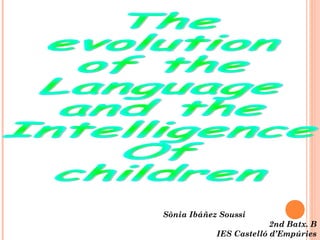Presentación definitiva
•Als PPT, PDF herunterladen•
1 gefällt mir•217 views
the evolution of the language and the intelligence of children
Melden
Teilen
Melden
Teilen

Weitere ähnliche Inhalte
Was ist angesagt?
Was ist angesagt? (19)
Ähnlich wie Presentación definitiva
Ähnlich wie Presentación definitiva (20)
Early Literacy Workshop at Proud fo My Culture 2020

Early Literacy Workshop at Proud fo My Culture 2020
What is Speech? Phonetics and the Theory of Multiple Intelligences

What is Speech? Phonetics and the Theory of Multiple Intelligences
ANGLO CONGRESS Storytelling with very young learners

ANGLO CONGRESS Storytelling with very young learners
Mehr von sonia
Mehr von sonia (9)
Presentación definitiva
- 1. Sònia Ibáñez Soussi 2nd Batx. B IES Castelló d’Empúries
- 2. INTRODUCCIÓ... Why did I chose this research project? Which were the main objectives?
- 3. WHY A LANGUAGE IS SO IMPORTANT… People = social being by nature. Why do we use the language?
- 4. THE ORAL EXPRESSION... Increasing the language. Dialogue = structure thinking and reinforces the security and self-esteem. Tales = help the develop of the imagination, understanding, speaking and thinking better.
- 5. MECHANISMS OF LANGUAGE ACQUISITION: The Imitation The Observation The Game
- 6. PSYCHOLINGUISTIC DEVELOPMENT IN THE EARLY YEARS Two stages: -Pre-linguistic stage. -Linguistic or verbal stage.
- 7. THE MOST RELEVANT FEATURES OF THE LINGUISTIC STAGE ... First words and sentences. Structure of the first phrases of the children: -Noun + verb: “Nena canta”. - Noun + adverb : “Galeta més”; “Galeta no”. -Noun + noun: “Pilota taula”; “cadira mama”. -The personal pronoun "I" appears when he/she is 3 years.
- 8. In the linguistic stage: -Appears: "no." -vocabulary: 150 words (2 years) and 1500 words (3years). -Do not forget that parents are models to follow for what they do more than what they say.